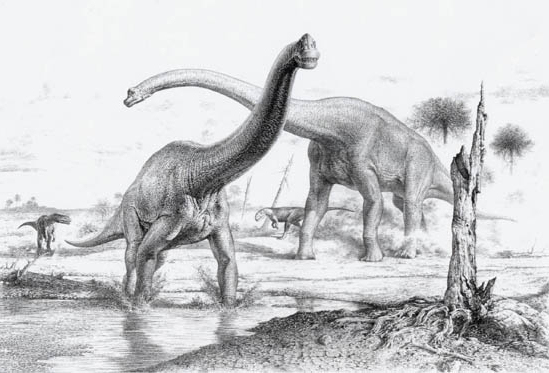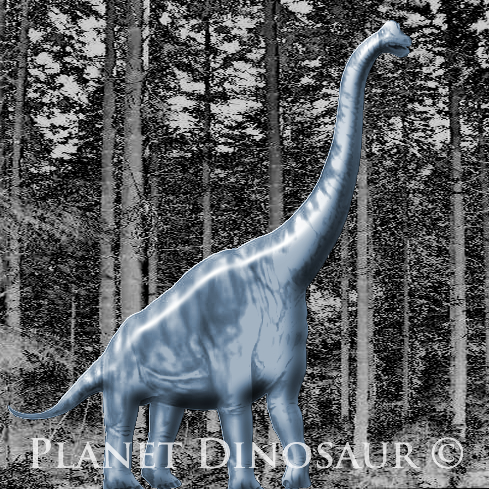Brachiosaurus altithorax - Saurischian Dinosaurs
Homepage > Saurischian Dinosaurs - Brachiosaurus altithorax
(arm lizard)
"brack-ee-oh-sor-uhss"
Describer Riggs, 1903
Also Known As --
Type of Species altithorax
Order Saurischia
SubOrder Sauropodomorpha
InfraOrder Sauropoda
Micro-Order --
SuperFamily --
Family Brachiosauridae
SubFamily --
Size 82 feet (25 meters) long
Period Early Cretaceous, 150 million years ago
Fossilsite Colorado, USA; Tanzania, Africa
Diet Herbivore
Brachiosaurus lived during the Early Cretaceous Period 150 million years ago in what is now North America and Africa. Brachiosaurus was a gigantic herbivore dinosaur. It grew up to 30- 50 tons and a length of 82 feet (25 meters). Brachiosaurus had an enormous long neck that could reach high into the trees. At a full stretch Brachiosaurus could reach up to 52 feet (16 meters) above the ground.
Brachiosaurus walked on all four legs. This dinosaur is different from other quadrupeds in the sense that its front legs were longer than its hind legs. This made the dinosaur slope down toward its short tail.
Brachiosaurus had nostrils on top of its head. From the large size of its nostrils, it could be said that Brachiosaurus possessed a good sense of smell. It probably used this to detect predators around it and to locate food sources. Brachiosaurus had 52 chisel-like teeth that were adapted for tugging and striping leaves away from trees.
Brachiosaurus head was small in proportion to its large body, its brain would have been small by looking at its skull. This suggests that the dinosaur was not very smart and may have functioned mostly on reflex.
Interesting Fact [Brachiosaurus got its name "arm lizard" from its long front legs that grew from its shoulders, as if they were arms.]
When looking at its long neck, researchers believe that brachiosaurus may have had a strong heart to sustain its blood pressure. Having a stable blood pressure is vital to have the animal working properly. When we look at brachiosaurus' neck at 40 feet (12 meters) above its heart, the pressure from the blood on its blood vessels would have been great, putting a strain on its heart. Because this fact, researchers believe that brachiosaurus had a form of "double pump" circulation, like mammals and birds do today. With this type of circulation the heart is separated into a left and right side. These halves share the work of circulating blood through its body, alleviating some of the strain on the heart.

It is believed by researchers that Brachiosaurus probably spent most of its walking hours feeding, being such an enormous dinosaur it would required massive daily intake of food to simply stay alive. A fully mature Brachiosaurus may have required 400 pounds of plant each day.
Brachiosaurus may have lived and travel in herds. Herds would have been made up of animals of all ages. Researchers can estimate how fast this dinosaurs traveled by measuring differences of their footprints, they were slow movers. These estimations puts Brachiosaurus at 2 miles per hour, which is half of an adult human.
Discovery
The first fossil finds were discovered in Colorado, in 1900. This find
was an incomplete skeleton, but researchers could tell that it was a new
type of dinosaur. This find stimulated a world wide research to find other
similar specimens.
Between 1909 and 1912, specimens of Brachiosaurus were discovered in Tanzania, East Africa. They were discovered by German paleontologist Werner Jenensch. It took hundreds of people to unearth the many bones and to prepare the specimen for display at the Humboldt Museum in Berlin. This skeleton display is the tallest complete dinosaur in the world.
Interesting Fact [When Brachiosaurus was first studied, its nose puzzled paleontologist. Since its nostrils are placed at the very top of its head, it was believed that this animal may have lived in the water, stretching its long neck to the surface where it could breathe using its nostrils like a snorkel. This idea has been dropped by paleontologists. Having Brachiosaurus' body mass under water would have created great pressure on its thoracic area, making it difficult for the animal to breathe.]
